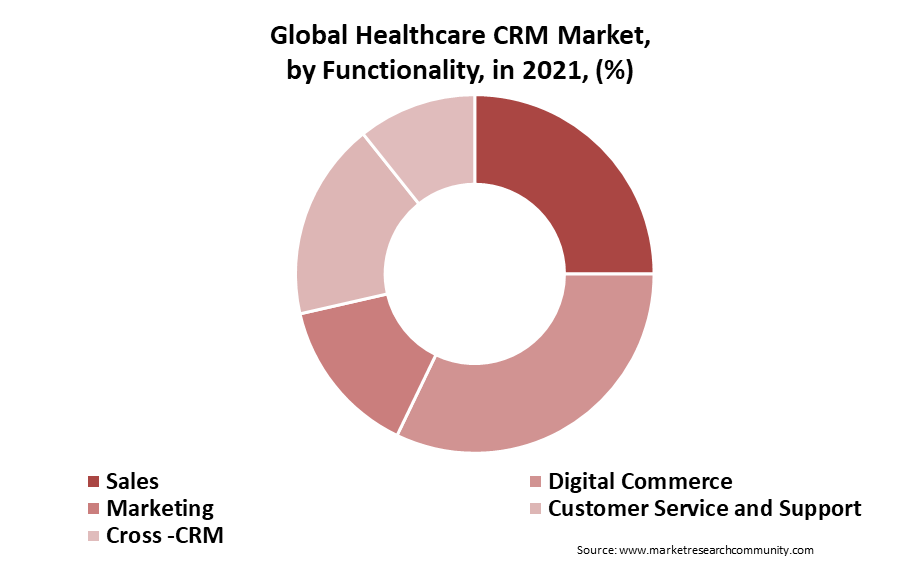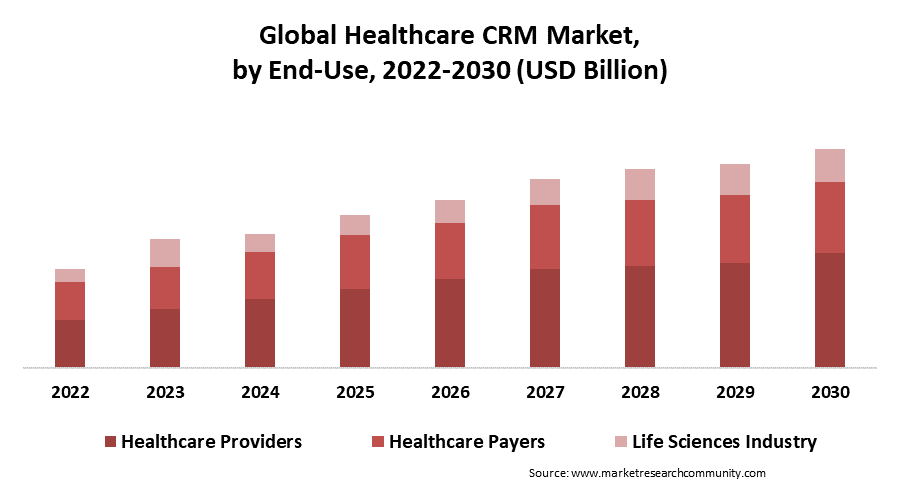Healthcare CRM Market Insights:
Healthcare CRM Market is projected to be worth USD 30.13 Billion by 2032, registering a CAGR of 8.3% CAGR during the forecast period (2024-2032), the market was valued at USD 14.70 Billion in 2024. In terms of functionality, the sales category held a leading share of 21.2% in the healthcare CRM market owing to the fastest growth in 2024. The cloud/web-based model accounted for the greatest proportion of the healthcare CRM market in 2024. In 2024, North America held a majority share of the healthcare CRM market, accounting for more than 50%, owing to outstanding network and IT growth in the region.
Healthcare CRM Market Dynamics:
Healthcare CRM is a commonly used name for a customer relationship management system, or CRM, used in the healthcare industry. It is also known as healthcare relationship management. Three types of CRM are widely used Service, Marketing, and Sales. During the COVID-19 pandemic, hospitals, clinics, and laboratories employed healthcare CRM platforms to schedule and manage patient visits.
Driver:
Healthcare CRM Market expansion is anticipated to be fueled by rising healthcare organization need for structured data and automation. Further, the healthcare CRM market is set to have significant growth due to the growing demand from patients for early disease identification via mobile monitoring and other disease monitoring devices. Hence, these factors are major drivers for the healthcare CRM market.
Opportunities
The approach to consumer outreach and marketing methods is expected to advance due to the changing dynamics and strategies of hospitals throughout the world as a result of the intense competition. Further, increasing mergers and acquisitions, and collaboration of the government with communities of patients, providers, and payers in the healthcare CRM market is expected to provide lucrative opportunities for the healthcare CRM market.
COVID-19 Analysis of Healthcare CRM Market:
The healthcare CRM market has been severely impacted since the COVID-19 epidemic in many different parts of the world. Shipments were impacted during the initial lockdown due to a labor shortage and the closure of a manufacturing facility. The pandemic’s initial effects on China were tremendous. However, the nation’s circumstances have stabilized, and all product and service production rates have increased. As a result, it is determined that COVID-19’s overall impact on the healthcare CRM market is moderate.
Healthcare CRM Market Report Cover:
| Report Attributes | Report Details |
| Study Timeline | 2019-2032 |
| Market Size in 2032 (USD Billion) | 30.13 Billion |
| CAGR (2024-2032) | 8.3% |
| By Functionality | Customer Service and Support, Digital Commerce, Marketing, Sales, Cross -CRM |
| By Deployment mode | On-premise Model, Cloud/Web-based Model |
| By End-use | Healthcare Providers, Healthcare Payers, Life Sciences Industry |
| By geography | North America– (U.S., Canada, Mexico)
Europe- (Germany, France, U.K., Russia, Italy, Spain, BENELUX, Rest of Europe) Asia Pacific- (China, Japan, India, South Korea, Australia, ASEAN, Rest of Asia Pacific) Latin America- (Brazil, Argentina, Chile, Rest of Latin America) The Middle East and Africa- (GCC, Turkey, Israel, Rest of MEA) |
| Key Players | Microsoft, Cerner Corporation (Oracle), IBM, SAP, Accenture, Zoho Corporation, hc1, LeadSquared, Salesforce, Veeva Systems, Talisma, Alvaria, NICE, Verint Systems Inc., Creatio |
Healthcare CRM Market Segment Analysis:
By Functionality
In terms of functionality, the sales category held a leading share of 21.2% in the healthcare CRM market owing to the fastest growth in 2024. On the other side, it is predicted that the Customer and Marketing Service and Support category is expected to expand significantly during the forecast period. The factor responsible is an abundance of CRM solutions and the measures taken by market key players. For instance, Pega for Healthcare & Life Sciences is a low-code platform that Pegasystems provides to pharmacy benefit managers, healthcare payers, providers, and members of the life science industry. It is designed to improve healthcare engagement, efficiency, and self-service which is expected to boost the growth of the healthcare CRM market.

By Deployment mode
The deployment mode segment is bifurcated into On-premise models, Cloud/Web-based Models. The cloud/web-based model accounted for the greatest proportion of the healthcare CRM market in 2024. Solutions that support data management through third-party provider hosts on an as-needed basis with options to scale up or down are included in this sector. More use of cloud technology increased the digitalization of the healthcare industry, and endeavors by leading corporations are some of the main drivers of the segment’s growth. IBM, SAP, Accenture, Cerner, Salesforce, and other leading providers of cloud-based CRM solutions are a few of the market leaders.
By End-Use
Healthcare providers dominated the market in 2024 by end-use, holding a share of more than 31.2%. Further, it is anticipated that the healthcare payer category is expected to expand at the fastest throughout the forecast period. Insurance companies are payers and hospitals, clinics, and different specialty facilities like hospital care and long-term care along with life sciences firms including pharmaceutical and biotech firms in addition to Clinical Research Organizations are providers (CROs). The usage of CRM solutions is anticipated to increase in the Life Sciences Industry area.
For example, GE Healthcare collaborated with Capgemini to create the SFDC Lightning Salescloud to improve the scheduling and logistics of the installation of its medical equipment. The answer assisted GE in reducing installation delays, enhancing supply chain management, and enhancing customer and staff satisfaction. Similar services are provided by Capgemini in partnership with Salesforce. Another business in the market, ScienceSoft USA Corporation, provides CRM software with capabilities like referral management, interoperability, automation, etc. to the healthcare sector.

By Region
In 2024, North America held a majority share of the healthcare CRM market, accounting for more than 50%, owing to outstanding network and IT growth in the region. Industry expansion is fueled by the introduction of the Affordable Healthcare Act (2010) and benevolent government programs like health connect and e-health. The market in the Asia Pacific is anticipated to develop profitably by over 10% during the projected period as a result of health care programs created by government organizations. Further, increased attention to the region’s medical tourism industry and health care infrastructure will boost consumer satisfaction and foster growth.
Healthcare CRM Market Competitive Landscape:
The competitive landscape of the market has been analyzed in the report, along with the detailed profiles of the major players operating in the industry. Further, the surge in Research and Development (R&D), product innovation, various business strategies, and product & Service launches have accelerated the growth of the Healthcare CRM market. Key players in the market include-
- Microsoft
- Cerner Corporation (Oracle)
- IBM
- SAP
- Accenture
- Zoho Corporation
- hc1
- LeadSquared
- Salesforce
- Veeva Systems
- Talisma
- Alvaria
- NICE
- Verint Systems Inc.
- Creatio
Table of Content
- Introduction
- Market Introduction
- Market Research Methodology
- Research Process
- Primary Research
- Secondary Research
- Data Collection Technique
- Data Sources
- Market Estimation Methodology
- Limitations of the Study
- Product Picture of Healthcare CRM
- Global Healthcare CRM Market: Classification
- Geographic Scope
- Years Considered for the Study
- Research Methodology in brief
- Parent Market Overview
- Overall Healthcare CRM Market Regional Demand
- Research Programs/Design
- Market Breakdown and Data Triangulation Approach
- Data Source
- Secondary Sources
- Primary Sources
- Primary Interviews
- Average mode primary breakdown ratio
- Market Dynamics
- Drivers
- Drivers
- Restraints
- Restraints
- Opportunity
- Impact forces on market dynamics
- Impact forces during the forecast years
- Industry Value Chain
- Upstream analysis
- Downstream analysis
- Therapeutic
- Direct Channel
- Indirect Channel
- Potential Customers
- Manufacturing/Operational Cost Analysis
- Pricing Analysis by Region
- Key product Landscape
- Regulatory Analysis
- Porter’s Analysis
- Supplier Power
- Buyer Power
- Substitution Threat
- Threat from New Entry
- Competitive Rivalry
- PESTEL Analysis
- Political Factors
- Economic Factor
- Social Factors
- Technological Factor
- Environmental Factors
- Legal Factor
- Covid-19 impact on Global Economy
- Covid-19 impact on Healthcare CRM Market demand
- Post-Covid Impact on Healthcare CRM Market Demand
- Impact Analysis of Russia-Ukraine Conflict
- Drivers
- Global Healthcare CRM Market Segmentation, Revenue (USD Billion), (2022-2030)
- By Functionality
- Customer Service and Support
- Digital Commerce
- Marketing
- Sales
- Cross -CRM
- By Deployment mode
- On-premise Model
- Cloud/Web-based Model
- By End-Use
- Healthcare Providers
- Healthcare Payers
- Life Sciences Industry
- By Functionality
- By Global Healthcare CRM Market Overview, By Region
- North America Healthcare CRM Market Revenue (USD Billion), by Countries, (2022-2030)
- US
- By Functionality
- By Deployment mode
- By End-Use
- Canada
- Mexico
- US
- Europe Healthcare CRM Market Revenue (USD Billion), by Countries, (2022-2030)
- France
- UK
- Spain
- Russia
- Italy
- BENELUX
- Asia Pacific Healthcare CRM Market Revenue (USD Billion), by Countries, (2022-2030)
- China
- Japan
- Australia
- South Korea
- India
- ASEAN
- North America Healthcare CRM Market Revenue (USD Billion), by Countries, (2022-2030)
- Latin America Healthcare CRM Market Revenue (USD Billion), by Countries, (2022-2030)
- Brazil
- Argentina
- Chile
- The Middle East and Africa Healthcare CRM Market Revenue (USD Billion), by Countries, (2022-2030)
- GCC
- Turkey
- South Africa
- Global Healthcare CRM Market Revenue: Competitive Analysis, 2021
- Key strategies by players
- Revenue (USD Billion and %), By manufacturers, 2021
- Player Positioning by Market Players, 2021
- Competitive Analysis
- AbbVie, Inc.
- Business Overview
- Business Financials (USD Billion)
- Product Category, Source, and Specification
- Main Business/Business Overview
- Geographical Analysis
- Recent Development
- Swot Analysis
- Microsoft
- Cerner Corporation (Oracle)
- IBM
- SAP
- Accenture
- Zoho Corporation
- hc1
- LeadSquared
- Salesforce
- Veeva Systems
- Talisma
- Alvaria
- NICE
- Verint Systems Inc.
- Creatio
- AbbVie, Inc.
- Market Research Findings & Conclusion
Disclaimer
Research Methodology
The Market Research Community offers numerous solutions and its full addition in the research methods to be skilled at each step. We use wide-ranging resources to produce the best outcome for our customers. The achievement of a research development is completely reliant on the research methods implemented by the company. We always faithful to our clients to find opportunities by examining the global market and offering economic insights.Market Research Community are proud of our widespread coverage that encompasses the understanding of numerous major industry domains. Company offers consistency in our research report, we also offers on the part of the analysis of forecast across a range of coverage geographies and coverage. The research teams carry out primary and secondary research to carry out and design the data collection methods.
